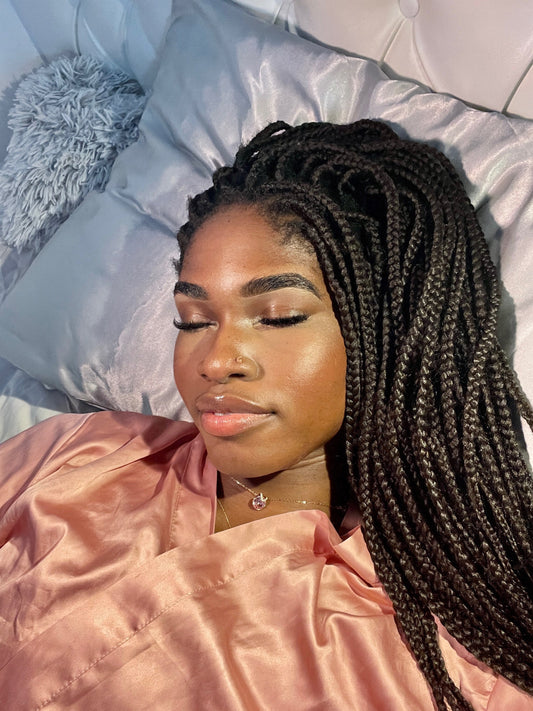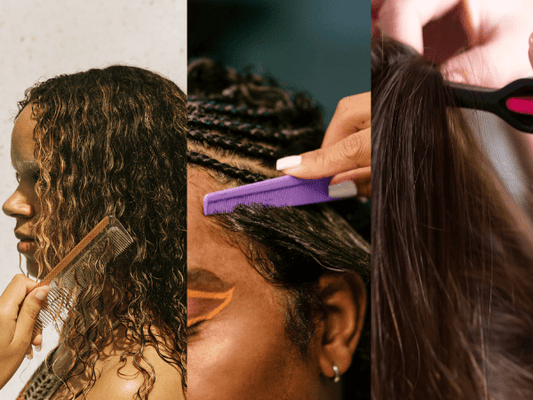Curl Types and Patterns
- Type 2 (Wavy): Hair that forms an "S" shape. It's subdivided into 2A (loose waves), 2B (medium waves), and 2C (deep waves with some curls).
- Type 3 (Curly): Hair that forms spirals or ringlets. It's categorized into 3A (loose curls), 3B (medium curls), and 3C (tight curls).
- Type 4 (Coily): Hair that forms tight coils or zig-zags. It includes 4A (soft coils), 4B (tight coils with a "Z" pattern), and 4C (very tight coils with less visible pattern).
Understanding your curl type is the first step in identifying the right care and styling techniques for your hair.
Curly Hair Care Terms
- Porosity: This refers to the hair's ability to absorb and retain moisture. Low porosity hair has tight cuticles that resist moisture absorption, while high porosity hair absorbs moisture quickly but also loses it easily.
- Density: The amount of hair strands on your head, affecting the volume of your hair. Hair can be low, medium, or high density.
- Width: Refers to the thickness of individual hair strands, categorized into fine, medium, and coarse.
Styling Techniques
- Plopping: A technique to dry curls by laying them on a cotton T-shirt or microfiber towel, then wrapping the hair to reduce frizz and enhance curl definition.
- Scrunching: Gently squeezing the hair upwards with a towel or hands to encourage curl formation.
- Diffusing: Using a diffuser attachment on a hair dryer to gently dry curls and enhance volume without causing frizz.
- Finger Coiling: Twirling small sections of hair around your finger to define curls.
- Shingling: Applying gel or cream to small sections of hair and smoothing through with fingers to define curls.
Hair Care Practices
- Deep Conditioning: Regular treatment with a nourishing conditioner to penetrate deeply into the hair shaft, improving hydration and elasticity.
- Co-Washing: Washing hair with conditioner only, to cleanse the scalp and hair without stripping natural oils. Ideal for maintaining moisture in curly hair.
- Clarifying: Using a deep-cleansing shampoo to remove buildup from products, oil, and dirt, typically used sparingly to avoid drying out the hair.
- Protein Treatment: A treatment to strengthen hair by filling in gaps in the hair cuticle with protein. Essential for damaged or high porosity hair.
- LOC Method: A moisturizing technique consisting of applying Liquid (water or leave-in conditioner), Oil, and Cream, in that order, to seal in moisture.
Product Types
- Leave-In Conditioner: A lightweight conditioner applied after washing to provide continuous moisture and ease detangling.
- Curl Cream: A styling product that provides moisture and definition to curls.
- Gel: A styling product used to hold and define curls, creating a "cast" around curls that is scrunched out once dry.
- Mousse: A lightweight foam that provides volume and hold without weighing down curls.
- Serum: A silicone-based product used to smooth frizz and add shine.
Common Curly Hair Challenges
- Frizz: Hair that appears dry, fuzzy, and stands away from the main curl pattern, often caused by humidity or damage.
- Single Strand Knots: Tiny knots that form on individual hair strands, common in coily hair types.
- Shrinkage: The reduction in hair length due to curl tightening, most noticeable in type 4 hair.
Curly Hair Care Tips
- Hydration is Key: Curly hair is naturally prone to dryness. Maintaining moisture through deep conditioning, regular hydration, and sealing with oils or butters is essential.
- Gentle Detangling: Use a wide-tooth comb or fingers to detangle hair when wet and conditioned to minimize breakage.
- Trim Regularly: Regular trims every 6-8 weeks can prevent split ends and promote healthy hair growth.
- Protective Styles: Styles that tuck away the ends of the hair, such as braids or twists, can protect hair from environmental damage and reduce manipulation.
- Sleep on Satin or Silk: To reduce friction and moisture loss at night, sleep on a satin or silk pillowcase, or use a satin bonnet.











